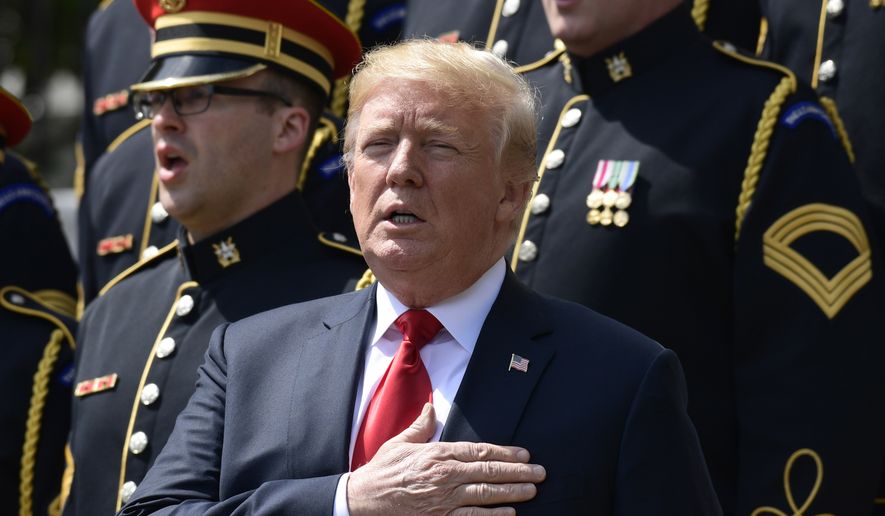President Trump oversaw a massive increase in the deficit during his first full year in office, the Treasury Department announced Monday, pointing to rising spending and stagnant taxes that threaten to send the government back into the realm of trillion-dollar shortfalls.
The government ended fiscal 2018 at $779 billion in the red, or 17 percent more than fiscal 2017, which was split between President Obama and Mr. Trump.
The news would have been even worse — an increase in the deficit of $162 billion instead of $113 billion — but for some payment shifts at the end of the fiscal year, the Congressional Budget Office said.
Even without that, it was the worst year since 2012, when the government was coming out of its stimulus spending binge. Analysts said trillion-dollar deficits are looming, perhaps as early as 2019.
“Deficits are rising — and fast,” said Maya MacGuineas, president of the watchdog group Committee for a Responsible Federal Budget, who calculated that this year’s shortfall works out to $6,200 per household.
The Trump administration said things weren’t so bad. Officials pointed to strong economic growth that they said will pull the government out of its budget tailspin — as long as Congress agrees to spending cuts.
“President Trump and this administration will continue to work with Congress to make the difficult choices needed to bring fiscal restraint, which, when matched with increasing revenue, will reduce our deficit,” said White House budget chief Mick Mulvaney.
But Mr. Trump has sworn off cuts to the biggest spending programs — the military, Social Security and Medicare — and there is not much he can do about rising interest payments.
Congress, meanwhile, has shown little inclination to cut domestic spending. It was a Trump-blessed deal to combine boosts in Pentagon and domestic spending that fueled most of the shortfall in 2018.
Democrats said Republicans, who control the White House and Congress, shoulder the blame for the sea of red ink.
House Minority Leader Nancy Pelosi, California Democrat, said Republicans’ tax cut package, which was approved late last year and took full effect earlier this year, has drained money that the government could have used to pay for the new spending.
“Under the Republican agenda, the rich get richer, and everyone else is stuck paying the bill,” she said.
But the Trump administration and congressional Republicans said money isn’t the problem.
The government took in $3.329 trillion, about $14 billion more than the previous year, despite the tax cuts. Outlays, however, soared $127 billion to reach $4.108 trillion.
“Spending is still the problem,” said Rep. Erik Paulsen, Minnesota Republican and chairman of Congress’ Joint Economic Committee.
Budget analysts disagreed, saying revenue should be increasing, not stagnant, while the economy is surging.
“Rather than taking advantage of this strong economy to improve the fiscal picture, Washington over the past year has made the situation worse,” said Robert L. Bixby, executive director of the Concord Coalition.
Michael A. Peterson, chairman of the watchdog Peter G. Peterson Foundation, said the U.S. is the only developed country whose debt-to-GDP ratio is growing.
“This is a reflection of just how irresponsible our budget policies have become,” he said.
As bad as the budget numbers are, they are gaining little traction on the campaign trail, where matters such as health care, immigration and the fight over Supreme Court Justice Brett M. Kavanaugh are absorbing far more oxygen.
Fiscal 2018 ran from Oct. 1, 2017, through Sept. 30, 2018. The government is already two weeks into the 2019 fiscal year, with the deficit again projected to rise.
Deficits are the annual shortfall, while debt is the accumulation over years of those deficits.
Since taking office, Mr. Trump has overseen an additional $1.6 trillion in debt. By contrast, Mr. Obama racked up $3 trillion in new debt during his first 21 months in office.
At $21.6 trillion total, the debt is increasingly a drain on the Treasury, with the government shelling out $325 billion on interest payments last year, up $62 billion in just 12 months.
Other big increases in spending came from Social Security, military, homeland security and Treasury Department outlays.
The biggest drop in spending came from the Education Department, where financial aid for college students fell dramatically.
On the revenue side, individual income tax receipts rose 6 percent to $1.684 trillion, and payroll taxes inched up to reach $1.121 trillion.
But corporate income taxes dropped 31 percent, serving as a drag on overall revenue.
• Stephen Dinan can be reached at sdinan@washingtontimes.com.




Please read our comment policy before commenting.